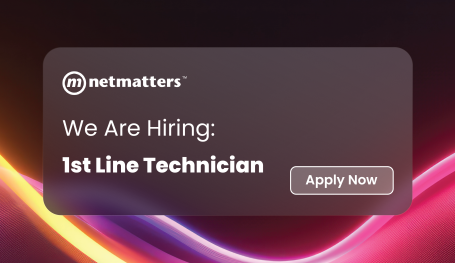-
Bespoke
Software
- Our Bespoke Software Services
- Bespoke CRM
- Business Automation
- Software Integrations
- Mobile App Development
- Bespoke Databases
- Sharepoint Development
- Operational Systems
- Business Central Implementation
- Internet of Things (IoT) Software
- Intranet Development
- Customer Portal Development
- Reporting Hub
- SAP S/4HANA Management
- IT Support
- Digital Marketing
-
Telecoms
Services
- Our Telecoms Services
- Business Mobile
- Hosted VoIP Provider
- Business VoIP Systems
- Business Broadband
- Leased Lines Provider
- 3CX Systems
-
Web
Design
- Our Web Design Services
- Bespoke Website Design
- eCommerce Website Design
- Pay Monthly Websites
- Branding & Design
- Mobile App Development
- Web Hosting
- Cyber Security
-
Developer
Course
- Our Developer Course Services
- Train For A Career In Tech
- Skills Bootcamp
- Scion Scheme Frequently Asked Questions
- Scion Collaborators
Happy 30th Birthday World Wide Web!

Posted by Netmatters

“Vague but Exciting”
This was the initial response to 33-year-old software engineer Sir Tim Berners-Lee’s pitch ‘Information Management: A Proposal”. This proposal detailed how computers could be used for the efficient sharing of information, starting what we know in 2019 as the World Wide Web.
As we celebrate the 30th anniversary of the World Wide Web, this original comment ‘vague but exciting’ still holds merit. The capacity for growth and understanding is still as exciting today as it was 30 years ago.
To celebrate the World Wide Web’s 30th birthday, we are going to look back on how the internet came to be what it is today, and how it can bring growth and success to your business in 2019 and beyond.
Creating a “Universal Space”
Like many of the world’s greatest ideas, the World Wide Web first came about as a solution to a small-scale problem. In 1989 Berners-Lee worked at CERN, a large-scale particle physics laboratory in Geneva. The scientists he worked for needed a more efficient way to share the data from their experiments. Berners-Lee devised a solution for documents to be shared across devices connected to the Internet. This solution took the form of three fundamental developments:
- Uniform Resource Locator (URL) to locate specific documents
- Hypertext Transfer Protocol (HTTP) to connect computers together
- Hypertext Markup Language (HTML) to format documents on computers
By the early 1990s the World Wide Web was growing in use in environments such as CERN. However, it was not readily available to the public. Berners-Lee became a fierce advocate for decentralising the commercial use of the internet. One of his most famous remarks came in 1998 when he said:
“You can’t propose that something be a universal space and at the same time keep control of it.”
This universal space began to take shape in 1994, with the introduction of the “Internet in a Box”. Only two years later Hotmail and ICQ emerged as the first publicly available email and instant messaging service respectively. Soon every home could not be without a computer.
“Between 1990 and 1997, the percentage of households in the United States owning computers increased from 15% to 35%.”
Source: “Issues in Labor Statistics” U.S. Department of Labor Bureau of Labor Statistics Summary 99-4 March 1999
“Like Neurons in a Giant Brain”
Since the internet became publically available, tech-savvy users were realising its untapped potential. One of the first notable examples of this was Napster, a website that gave ‘peer to peer file sharing’ a user-friendly interface for music to be exchanged through MP3 files.
Napster grew over the course of two years to nearly 80 million registered users before being shut down in 2001 following charges of copyright infringement. This same year saw the launch of iTunes, which “despite launching with just 200,000 songs, it reached sales of 250,000 within 24 hours.”
File sharing opened up new spaces to form communities online. The internet became more than just connecting devices, it became about connecting people as Stephen Hawking would remark:
“We are all now connected by the Internet, like neurons in a giant brain.”
The first thing this quote brings to mind today is the meteoric rise of social media. In 2019 there are an abundance of social media platforms. However, few are likely to remember SixDegrees.com, the first dedicated social media website. SixDegrees.com was created by Andrew Weinreich and was based on the concept of ‘six degrees of separation’. At the peak of its popularity it had over 3,500,000 members before being bought for 5 million.
2003 was a big year for social media, with the founding of both LinkedIn and Myspace. Less than a year later, Harvard student Mark Zuckerberg launched what we now know to be Facebook, one of the biggest websites in the world today.
“A Whole New Paradigm”
By June 2010 there were 1.97 billion internet users, a growth of 14% from the previous year. The internet had already undergone countless shifts, but the market would be transformed by a new device: the smartphone.
IBM released the first version of a ‘smartphone’ in 1994 with the Simon Personal Communicator. However, the technology of Internet-connected phones was still in its infancy, so users continued to make use of desktop computers.
This would be forever changed in 2007 with the launch of the iPhone. The market had never experienced a mobile phone that was so technologically advanced. It took just a year for iPhone sales to increase from 1.4 million to 11.6 million, a growth of over 728%. It was this surging demand for smartphones that led Thorstein Heins to predict:
“The future is mobile computing – smartphones and tablets are just elements of it. The industry is on the verge of a whole new paradigm.”
With the growing dominance of smartphones came the introduction of applications. Internet usage began to grow outside the limits of traditional browsers, making it easier than ever before for companies to connect with smartphone users on the go. The last ten years have certainly been the age of the smartphone. New devices such as the Samsung and Google Pixel indicate that the market is showing no signs of slowing down:
“In 2018, 52.2 percent of all website traffic worldwide was generated through mobile phones, up from 50.3 percent in the previous year.”
Source: Statista – “Mobile Share of Web Visits Worldwide 2018”
Is Your Website Up to Today’s Standards?
In 2019 the potential for companies to provide something meaningful to their audience online is unprecedented. However, we at Netmatters find that for many businesses this potential remains untapped.
Nowadays a company should consider their website as their chance to make a first impression, showcasing their expertise and the quality of their service. For a business to survive in 2019 and beyond, the new norm is a high-quality website.
The reason behind the need for a high-quality website is to ensure it as easy as possible for users to get in touch with the brand. Brand appearance is important too due to the amount of competition in the online marketplace in today's culture.
Netmatters creates Bespoke Websites and multi-channel digital marketing campaigns. We are well-versed in catering to businesses of all sizes, from international online retailers to SMEs.
We know more than anyone about the role of mobile phones in the average online experience. We can create compelling websites that function well on both desktop and mobile. Our team of software developers can also assist you in creating a Bespoke Mobile App. An app opens a world of possibilities in how you can reach and better serve your audience.
We understand that not everyone is able to afford a bespoke solution for their website, this is why we offer our audiences Pay Monthly Websites. These are more aimed at start ups and smaller businesses who are looking for a cost-effective website solution. For an affordable fee you can have a quality website built and maintained by a team of experts. This is sure to give you peace of mind about your online presence and your handling of costs.
Once a client’s website is up and running, they can also enlist our expert Digital Marketing team. Our digital marketers are responsible for driving regular traffic to your website, boosting your website’s position search engine reults pages. This is accomplished through a mix of design, copywriting, social media and search engine optimisation.
We also have the in-house resource to enable us to monitor your website and ensure you remain connected, with our proactive, expert IT Support. From Managed IT Support to IT Consultancy to Data Backup, Netmatters have it covered.
How does all of this sound to you? Why don’t you celebrate the World Wide Web’s 30th birthday by using it to take your business to new heights? Contact us via the form below or ring us on 01603 515007 today.



